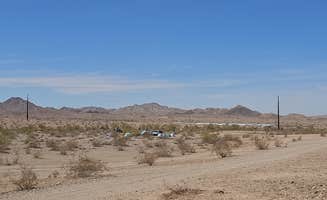Tent campsites near Parker, Arizona concentrate primarily on public lands managed by the Bureau of Land Management. The Colorado River defines the landscape, creating a natural border between Arizona and California with camping options on both sides. Summer temperatures regularly exceed 110°F, making spring and fall the preferred camping seasons. Winter lows rarely drop below freezing, attracting seasonal campers seeking milder weather.
What to do
Stargazing opportunities: At Havasu Heights, minimal light pollution creates ideal conditions for night sky viewing. "There's not a lot of light pollution so you can get great stars and moon pictures," notes camper Bare Soul W., who appreciates the location for astrophotography.
Jeep excursions: The terrain surrounding Parker allows for off-road exploration on established trails. Savannah A. reports, "I full time in a class c and flat tow my Jeep and was able to get about half a mile off the main road for my own slice of heaven." Many dispersed sites serve as excellent basecamps for day trips.
Town access: Parker offers supply runs within a short drive of most campsites. According to Steven S. at Havasu Heights, "Bullhead one way lake havasu the other," referencing the convenient location between two larger towns for more substantial shopping or activities.
What campers like
Cell connectivity: Many BLM sites maintain surprisingly good coverage despite their remote nature. Greg L. noted at BLM dispersed camping spur at MP 133.8, "Cell service good," making these locations viable for remote workers needing connectivity while camping.
Accessibility: Most areas feature roads manageable by standard vehicles, though conditions vary. The BLM camping spur received positive feedback from Greg L., who appreciated the "good wide graded gravel road accesses several nice dispersed sites."
Affordability: The free camping on BLM land appeals to budget-conscious travelers. When staying at BLM Earp-Parker to Needles Wagon Road Dispersed, Greg L. confirmed the sites are "Free dispersed, no toilets, trash, table, and no Shade!" highlighting the trade-off between cost and amenities.
What you should know
Road conditions: Access roads to camping areas vary significantly in quality. Greg L. gave the wagon road area three stars specifically "due to slow rocky road access," warning that "The turnoff is difficult to see in time so be careful for the fast moving semi traffic behind ya."
Site preparation: Ground conditions often require some work before setting up camp. Michael S. advises, "I learned quick that I need to add a shovel to my essential supplies for BLM camping. My van was able to negotiate making an entrance, but I am leary of getting stuck."
Weather considerations: The desert climate brings significant temperature swings and wind. Lily S. experienced challenging conditions at North of Rovey's Rock: "Mid Spring the wind was fairly constant with some decent gusts, got pretty chilly at night." Pack accordingly with gear suitable for both hot days and cool nights.
Tips for camping with families
Location selection: Sites farther from main roads offer more safety and privacy. Lily S. recommends: "Decent BLM site if you don't mind a bit of desert scrubland camping. No shade, no wind break, but plenty of road to get away from the highway noise if you're willing to drive a bit."
Convenience planning: Some areas balance remoteness with access to necessities. At Havasu Heights, Steven S. notes, "Internet walks through small neighborhood store at the rv park across street," identifying resources within walking distance.
Site leveling: Inspect potential campsites before committing, especially with larger setups. Savannah A. advises, "There are lots of flat areas for easy setup, but there are also quite a few areas that would be challenging to level. Depending on your rig you may want to walk the area first."
Tips from RVers
Solitude balance: Finding privacy often requires driving further from entry points. Michael G. observed at the Colorado River sites, "From Parker all the way to I-40, you have large graded areas that have an RV, Toy Hauler, or 5th wheel trailer parked about every 300 ft. Some vans mixed in there too."
Highway proximity: Consider noise levels when selecting sites near major roads. Greg L. notes that "Hwy noise not too bad if you camp up by the canal," suggesting specific locations farther from highways offer quieter experiences.
Preparation essentials: The primitive nature of dispersed camping requires complete self-sufficiency. Bring extra water containers, waste disposal bags, and solar charging capabilities since no hookups exist at any of these primitive tent campgrounds near Parker.


